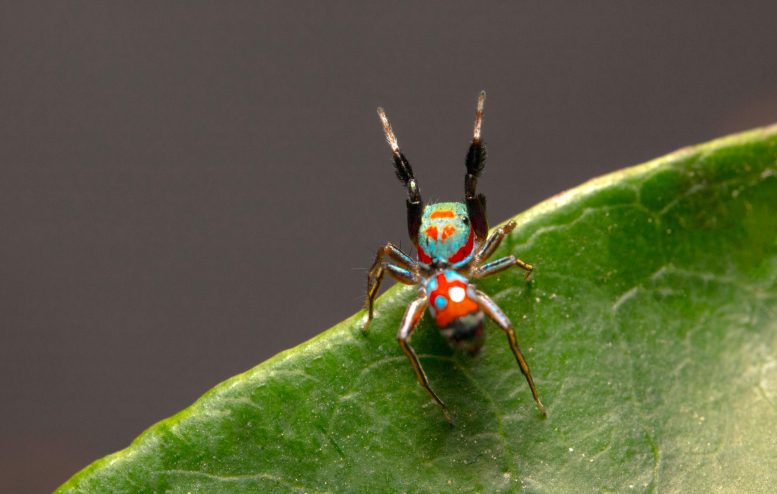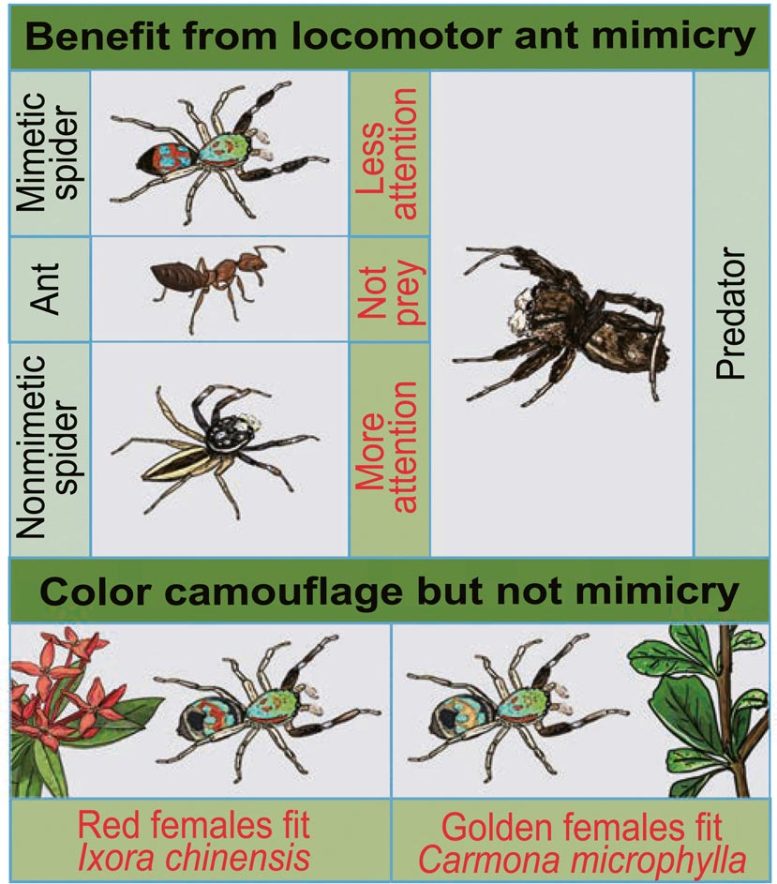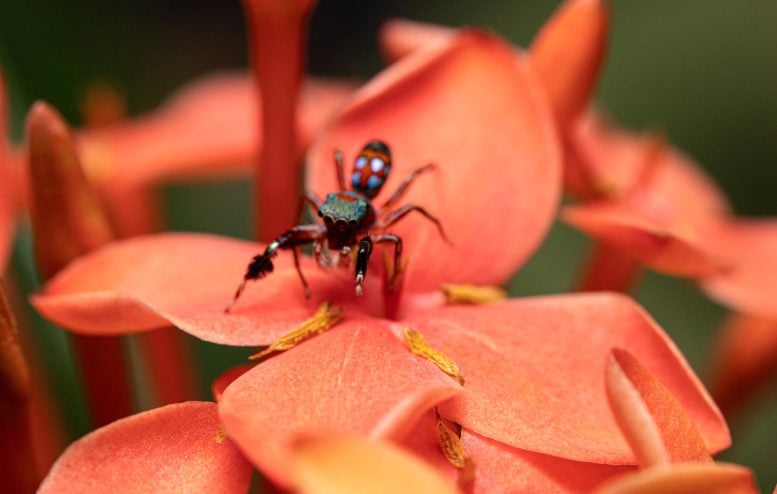
This is a photo of Siler collingwoodi, an ant-mimicking spider. This species of jumping spider uses a combination of camouflage and ant-mimicry for protection from predators, according to a study published in iScience. The spiders are known to move similarly to ants and their bright coloration blends well with their environment. The spiders raise their front legs to mimic ant antennae, bob their abdomens, and lift their legs to mimic ant movement, with their gait and trajectory resembling multiple ant species rather than one specific ant. This general mimicry may enable them to expand their habitats. Credit: Hua Zeng
The Siler collingwoodi, a jumping spider species, uses camouflage and ant-mimicry as defenses against predators, blending with plants and adopting ant-like movement to evade spider predators, but not praying mantises, a study in iScience revealed. However, limb loss hampers this mimicry, increasing their susceptibility to attacks.
A species of tiny, colorful jumping spider employs two lines of defense to avoid being eaten: camouflaging with plants and walking like an ant. Researchers report May 17th in the journal iScience that this combination of camouflage and movement mimicry helps the spiders evade spider-eating spiders but does not deter hungry praying mantises.
Mimicking ants is a good defense option because they do not make for good eating; ants often have spiny defenses and biting mandibles (and they’re not afraid to fight back), and many also carry chemical repellants or venom. Though the focal spider of this study—Siler collingwoodi—was already known to move in an ant-like fashion, the researchers wanted to know how accurate its mimicry is, whether it mimics more than one ant species, and how effective this mimicry is at discouraging predators.
The research team also explored the role of the spider’s brilliant coloration. “Unlike typical ant-mimicking spiders that mimic the brown or black body color of ants, S. collingwoodi has brilliant body coloration,” says first author Hua Zeng, an ecologist at Peking University. “From a human’s perspective, it seems to blend well with plants in its environment, but we wanted to test whether their body coloration served as camouflage to protect against predators.”
To understand how ant-mimicry helps these spiders avoid being eaten, the researchers collected wild ant-mimicking spiders from four geographic locations in southern Hainan, China, and brought them back to the lab. For comparison, they also collected another type of jumping spider that doesn’t mimic ants, as well as five co-occurring ant species that they thought might serve as models.
Back in the lab, the researchers characterized and compared how the ants and spiders moved in terms of how they used individual limbs, as well as their speed, acceleration, and whether they followed a straight path or took a more tortuous trajectory.
They found that, rather than jumping like most jumping spiders, S. collingwoodi move like ants: by raising their front legs to mimic an ant’s antennae, bobbing their abdomens, and lifting their legs to walk in an ant-like manner. Of the five ant species, the spiders’ walking style most closely resembled the three smaller ant species, who are also closer to it in size.
“S. collingwoodi is not necessarily a perfect mimic, because its gait and trajectory showed high similarity with multiple ant species,” says Zeng. “Being a general mimic rather than perfectly mimicking one ant species could benefit the spiders by allowing them to expand their range if the ant models occupy different habitats.”
Next, the researchers tested the spider’s defenses against two likely predators: a similarly sized jumping spider with color vision that specializes in preying upon other spiders (Portia labiata) and a praying mantis (Gonypeta brunneri) that is a generalist predator with a monochromatic visual system.

This is a graphical abstract that explains how the jumping spider Siler collingwoodi mimicks the way ants walk to avoid being eaten. The spiders are also brightly colored, which may help them to camouflage with plants. Credit: Zeng et al.
To explore the role of color camouflage, the researchers modeled how the two predators would perceive S. collingwoodi relative to the other prey species against the background of two plants that the spiders live on—the red-flowering West Indian jasmine (Ixora chinensis) and the Fukien tea tree (Carmona microphylla). They found that the ant-mimicking spiders were better camouflaged from both spider and praying mantis predators on the jasmine plant than the tea tree plant.
When the predators were given the choice of the ant-mimicking spider and the other jumping spider, the predatory spider was more likely to attack the non-mimic; out of 17 trials, the spider launched 5 attacks, all of which were towards the non-mimic. Praying mantises, however, attacked both prey species with equal alacrity.
“We initially thought that both predators would behave similarly in the antipredation experiments, but in fact the simulated ant locomotion of Siler collingwoodi only worked for the jumping spider predator, while the praying mantis showed indiscriminate attacks on both ants and mimics,” says senior author Wei Zhang, an evolutionary ecologist at Peking University.
This difference might be driven by each predator’s likelihood of being injured from eating an ant. The praying mantises are much larger than their prey, so they can get away with eating spiny ants without risking grave injury, but this is not the case for the predatory spiders.
“For the spider predator, a random attack on an ant could result in injury, so they are very careful predators and will only attack if they can distinguish S. collingwoodi from ants with a high degree of certainty,” says Zhang.
However, losing a limb compromised the ant-mimicking spiders’ ability to avoid the predatory spider’s attention, probably by preventing them from accurately mimicking ants.
Reference: “Imperfect ant mimicry contributes to local adaptation in a jumping spider” by Hua Zeng, Dong Zhao, Zixuan Zhang, Huize Gao and Wei Zhang, 17 May 2023, iScience.
DOI: 10.1016/j.isci.2023.106747
Funding: National Natural Science Foundation of China, Beijing Natural Science Foundation, Peking-Tsinghua Center for Life Science










Be the first to comment on "Master of Disguise: The Ant-Plant-Spider Triple Threat!"